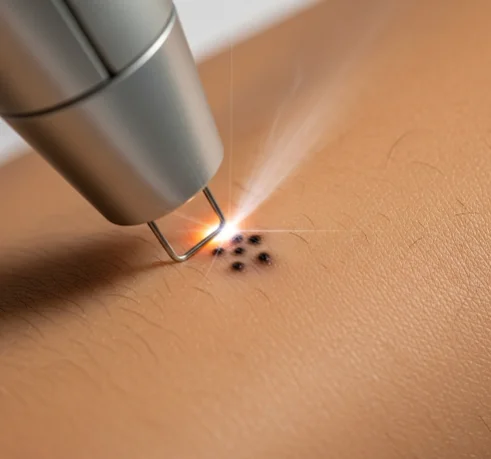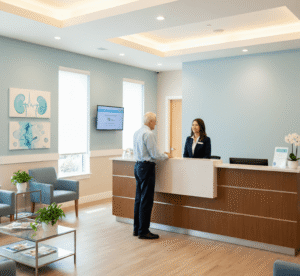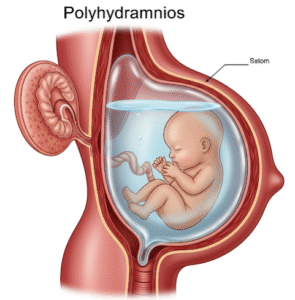What it is
Pigment removal Pico refers to the use of picosecond lasers (often called pico lasers) for treating unwanted pigmentation in the skin. These lasers emit ultra-short pulses of energy (trillionths of a second), which shatter pigment particles into tiny fragments that are then naturally cleared by the body.
Unlike older nanosecond lasers, pico lasers are faster, more precise, and gentler, making them highly effective for pigmentation while minimizing damage to surrounding skin.
In Korea, pigment removal with pico lasers is one of the most in-demand treatments for patients with:
- Melasma
- Sunspots and freckles
- Post-inflammatory hyperpigmentation (PIH)
- Age spots and lentigines
- Uneven skin tone and dullness
Korean clinics often integrate pico treatments with skin boosters, regenerative injectables, and K-beauty aftercare, ensuring not just pigment removal but also overall skin rejuvenation.
Why it’s done
Patients seek pigment removal with pico lasers to:
- Eliminate dark spots and hyperpigmentation.
- Improve skin clarity for the “glass skin” effect.
- Correct melasma and freckles common in Asian skin.
- Enhance overall complexion → Brighter, smoother skin tone.
- Prevent recurrence by maintaining healthier skin with regular touch-ups.
In Korea, pigmentation treatment is not just about removing spots—it’s about creating even-toned, radiant skin that matches the country’s beauty ideals.
Alternatives
Other treatment options for pigmentation include:
- Lasers & light therapies
- Q-switched Nd:YAG (older standard, replaced by pico in many clinics).
- IPL (intense pulsed light) for superficial pigmentation.
- Topical therapies
- Prescription creams with hydroquinone, tretinoin, or corticosteroids.
- Brightening agents like vitamin C, arbutin, tranexamic acid, and niacinamide.
- Chemical peels
- Glycolic, salicylic, or TCA peels to exfoliate pigmented layers.
- Microneedling with brightening serums
- Enhances penetration of pigmentation-lightening agents.
- Lifestyle approaches
- Strict sun protection (SPF is essential in all Korean protocols).
- Stress management, since melasma can worsen with stress.
Preparation
Before pigment removal with pico lasers:
- Consultation → Korean clinics use AI-based skin analysis cameras to measure pigment depth and distribution.
- Medical history → Allergies, photosensitivity, medications (e.g., isotretinoin) reviewed.
- Pre-procedure care
- Stop retinoids, acids, and exfoliants 5–7 days before.
- Avoid tanning or sunburn before treatment.
- Skin priming → Some clinics prescribe brightening creams or oral antioxidants pre-treatment to improve results.
- Expectation counseling → Multiple sessions (typically 3–6) are required for best outcomes.
How it’s Done
A typical pigment removal pico laser session in Korea involves:
- Cleansing → Removal of makeup and sunscreen.
- Numbing cream → Applied for comfort (though pico is relatively tolerable).
- Laser treatment →
- Pico laser pulses delivered across pigmented areas.
- Different wavelengths used (532 nm for superficial spots, 1064 nm for deeper pigmentation).
- Settings customized for Asian skin to avoid PIH.
- Post-laser soothing → Cooling mask, LED healing light, or antioxidant serums applied immediately.
⮕ Each session lasts 15–30 minutes.
Recovery
Pico laser treatments are known for minimal downtime:
- Mild redness or swelling → Lasts 1–2 days.
- Tiny darkening (micro-crusting) of spots → Flakes off within 5–7 days.
- Skin brightening noticeable after 1–2 weeks.
- Final results → Build gradually over several sessions.
In Korea, recovery is enhanced with:
✔️ Cooling packs and LED therapy.
✔️ K-beauty calming skincare (centella asiatica, panthenol, hyaluronic acid).
✔️ Sunblock and antioxidant serums to prevent recurrence.
Complications
Pico lasers are safe, especially for Asian skin, but risks include:
- Temporary redness or sensitivity.
- Post-inflammatory hyperpigmentation (rare when performed conservatively).
- Uneven results if maintenance sessions skipped.
- Rare blistering or scarring (usually from overly aggressive settings).
Korean dermatologists minimize risks with multi-session, low-energy protocols designed for gradual but safe pigment removal.
Treatment Options in Korea
Korea leads globally in pico laser technology and pigmentation care. Unique features include:
- Cutting-edge devices → PicoSure, PicoWay, Discovery Pico, and premium Korean-made pico lasers.
- Combination therapies
- Melasma: Pico laser + tranexamic acid infusion + Rejuran Healer.
- Freckles/sunspots: Pico laser + IPL or fractional laser.
- PIH: Pico laser + PRP or calming serums.
- Signature Korean skin programs
- “Pico Toning” → Gentle whole-face laser for even skin tone.
- “Pico Fractional” → For both pigmentation and texture.
- “Pico + Skin Booster” → Laser paired with hydration injections.
- Preventive maintenance → Many patients in Korea undergo quarterly pico sessions for ongoing skin clarity.
- Medical tourism appeal → Pico pigment removal is one of the top-requested dermatology treatments in Seoul, often bundled with whitening facials and regenerative boosters.
✅ Key Point: Pigment removal Pico in Korea is a safe, advanced, and highly effective solution for melasma, freckles, sunspots, and uneven skin tone. With state-of-the-art devices, multi-step treatment plans, and K-beauty aftercare, Korean clinics achieve the coveted clear, radiant “glass skin” look.













